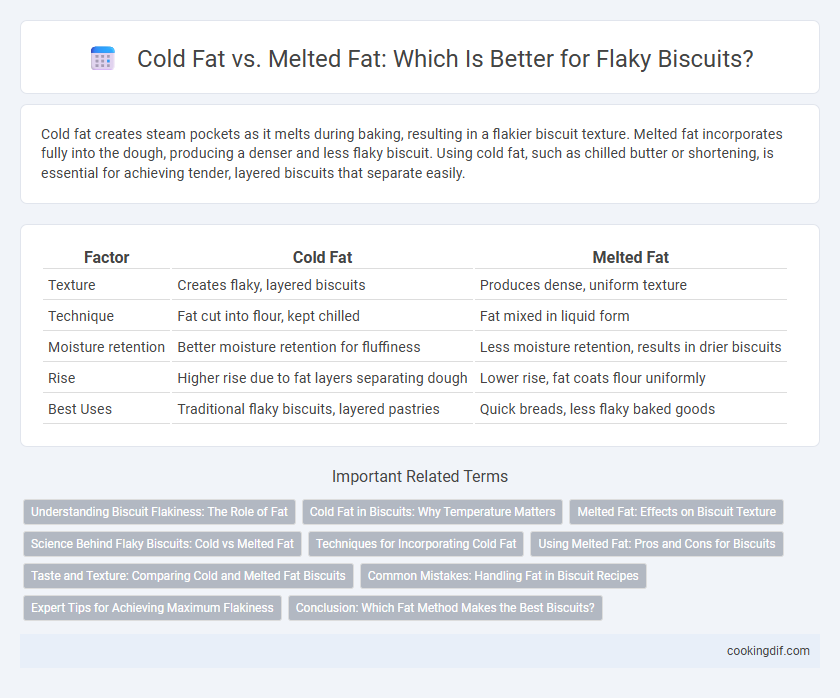Cold fat creates steam pockets as it melts during baking, resulting in a flakier biscuit texture. Melted fat incorporates fully into the dough, producing a denser and less flaky biscuit. Using cold fat, such as chilled butter or shortening, is essential for achieving tender, layered biscuits that separate easily.
Table of Comparison
| Factor | Cold Fat | Melted Fat |
|---|---|---|
| Texture | Creates flaky, layered biscuits | Produces dense, uniform texture |
| Technique | Fat cut into flour, kept chilled | Fat mixed in liquid form |
| Moisture retention | Better moisture retention for fluffiness | Less moisture retention, results in drier biscuits |
| Rise | Higher rise due to fat layers separating dough | Lower rise, fat coats flour uniformly |
| Best Uses | Traditional flaky biscuits, layered pastries | Quick breads, less flaky baked goods |
Understanding Biscuit Flakiness: The Role of Fat
Cold fat, such as chilled butter or shortening, creates distinct layers in biscuit dough by solidifying during baking and producing steam, which enhances flakiness. Melted fat, however, integrates fully with the flour, resulting in a denser texture and less pronounced layers. Properly handling cold fat is critical for achieving the classic flaky structure characteristic of high-quality biscuits.
Cold Fat in Biscuits: Why Temperature Matters
Cold fat in biscuits creates distinct layers by melting slowly during baking, resulting in a flaky texture that is prized in traditional recipes. The temperature of fat influences gluten development; cold fat inhibits overmixing and limits water absorption, ensuring tender, flaky layers. Using chilled butter or shortening effectively disrupts the dough structure, maximizing biscuit flakiness and rise.
Melted Fat: Effects on Biscuit Texture
Melted fat in biscuit dough results in a tender texture with less distinct flakiness compared to solid fat, as it evenly coats flour particles and limits gluten development. This method produces softer biscuits with a more uniform crumb structure, often preferred for moist and cake-like consistency. Bakers seeking pronounced layers and flaky bites typically favor solid or chilled fats over melted fats.
Science Behind Flaky Biscuits: Cold vs Melted Fat
Cold fat, such as chilled butter or shortening, creates steam pockets during baking, resulting in distinct layers and enhanced flakiness in biscuits. Melted fat integrates fully with the flour, leading to a denser, less flaky texture by inhibiting steam formation. Scientific studies highlight that maintaining fat in solid form during dough preparation is critical for achieving optimal biscuit flakiness.
Techniques for Incorporating Cold Fat
Using cold fat in biscuit dough creates steam pockets during baking, which leads to flakier, lighter layers. Techniques for incorporating cold fat include cutting chilled butter or shortening into small, pea-sized pieces and gently mixing it into the flour without overworking the dough to prevent melting. Chilling the dough before baking further preserves the fat's temperature, enhancing flakiness and texture.
Using Melted Fat: Pros and Cons for Biscuits
Using melted fat in biscuits results in a tender crumb but often sacrifices the traditional flaky texture achieved with cold fat. Melted fat integrates evenly throughout the dough, producing a uniform crumb but can inhibit the steam pockets that create layers and flakiness. While easier to mix and less labor-intensive, melted fat biscuits lack the distinct flaky layers preferred in classic biscuit recipes.
Taste and Texture: Comparing Cold and Melted Fat Biscuits
Cold fat in biscuits creates distinct layers that result in a flaky, tender texture due to the fat melting during baking and releasing steam, which puffs up the dough. Melted fat produces a denser, less flaky biscuit with a softer texture, often sacrificing the desired crumb structure for a richer mouthfeel. Taste-wise, cold fat preserves a light, buttery flavor, while melted fat imparts a uniform richness but can lead to greasier notes.
Common Mistakes: Handling Fat in Biscuit Recipes
Cold fat, such as chilled butter or shortening, is crucial for creating flaky biscuits because it melts during baking, releasing steam that forms layers. A common mistake is using melted fat, which integrates too thoroughly with the flour, resulting in dense, cakey biscuits rather than flaky ones. Proper handling involves cutting cold fat into the flour until it resembles coarse crumbs, preserving small fat pockets that enhance biscuit texture.
Expert Tips for Achieving Maximum Flakiness
Cold fat, such as chilled butter or shortening, creates steam pockets during baking that lead to superior biscuit flakiness by preventing the fat from fully blending into the dough. Expert tips recommend cutting cold fat into flour until pea-sized pieces remain to ensure distinct layers and optimal texture. Using melted fat results in a denser biscuit as it incorporates fully, eliminating the critical flakiness caused by solid fat pockets.
Conclusion: Which Fat Method Makes the Best Biscuits?
Using cold fat, such as chilled butter or shortening, produces the flakiest biscuits because it creates distinct layers as the fat melts during baking. Melted fat tends to integrate fully into the dough, resulting in a denser and less flaky texture. For optimal biscuit flakiness, cold fat remains the preferred method, ensuring light, tender layers.
Cold fat vs melted fat for biscuit flakiness Infographic

 cookingdif.com
cookingdif.com